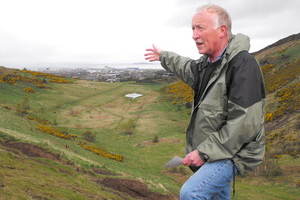
How do you evaluate a landscape? It is a question that lies at the heart of decision-making on controversial developments in the countryside, such as wind farms or new highways. Since the 1970s landscape evaluation has become a very technocratic process, much to the frustration of many non-professionals who may care deeply about a place but feel their views count for little.
I have been part of a project led by Planning Aid for Scotland (www.planningaidscotland.org) that has brought together artists and planners to try to create new ways of looking at places. It’s been fun and productive. The project is called “By Leaves We Live” and is funded by Creative Scotland, Scotland’s national development agency for the arts and creative industries.
“By Leaves We Live” is a phrase used by Patrick Geddes, one of the founding figures of town planning, and a passionate champion of Scottish culture. Geddes argued “How many people think twice about a leaf? Yet the leaf is the chief product and phenomenon of Life: this is a green world, with animals comparatively few and small, and all dependent upon the leaves. By leaves we live. Some people have strange ideas that they live by money. They think energy is generated by the circulation of coins. But the world is mainly a vast leaf-colony, growing on and forming a leafy soil, not a mere mineral mass: and we live not by the jingling of our coins, but by the fullness of our harvests.”
Poetry and Place
I have been one of six planners working with a poet, Andrew Sclater, who has also worked professionally as a landscape gardener. We took a site called Hunter’s Bog, a “U-shaped” valley beneath the highest hill in Edinburgh. On a cold, wet and windy May morning we went up there, and hunched down overlooking the site. Andrew invited us to clear our minds for a few moments, then to each write short notes on a postcard about what we liked about the site and what we didn’t like.
He followed this by giving us a series of prompts, to which we had to write down the first word or two that came in our minds. It was a bit like being on a psychiatrist’s sofa, but we were on the side of a hill. Prompts included things like “The sounds you hear”, “The animals you can’t see”, but also specific parts of the site, such as an abandoned quarry.
We then assembled all our separate words into a long list. This was more challenging than you might think, as some of the responses were quite personal. Andrew had done a good job in building up a sense of trust amongst the group. What emerged were some quite contrasting responses to the same landscape. For example, most of the group loved the wildness of this place and disliked intrusive urban views or traffic noise; however, I found it a rather frightening place, where one slip could mean bruises or a broken bone. OK, I always have been an urban wimp, I know.
At a later session we went over this list, and discussed how we might create maps using these words. The aim was to find a way of communicating our feelings about this landscape. We did this in groups of two, so three different approaches were explored. Andrew is still working on the final output from the project, but I think we have found a way that ordinary people can work together to share their feelings about a landscape, and then agree on a presentation of shared sentiments througha simple map.
Feelings versus “Science”
What emerged very clearly was that a landscape can evoke deep feelings and long-buried memories from people. The argument we are making is that these “soft” responses to a place are valid, and should not be ignored.
In contrast, in the late 1960s and 1970s there was a big push amongst professionals and researchers to make landscape assessment a more “objective” process. Techniques were developed to quantify the qualities of a landscape. For a summary of this extensive field see http://www.macaulay.ac.uk/ccw/task-two/evaluate.html.
Landscapes and Economic Development
Landscapes are an integral part of rural areas. They are often interwoven with the history and culture of a place and the communities who live there. There is always the risk that landscape conservation is seen as the opposite to economic development. However, a capacity to explore a landscape and one’s own feelings about it, is an important part of being in a place. This is not just true in spectacular places – even ordinary landscapes carry deep meanings, if you know where to look for them. They tell us stories about the place and about our own relation to that place. Perhaps it might be possible to apply some of the ideas and methods of the By Leaves We Live project to the places where IC members live and work.
![]()